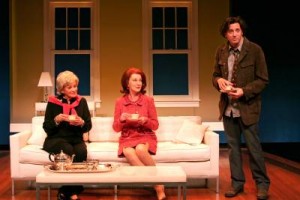
South Coast Repertory has a bonafide hit on its hands. Richard Greenberg’s latest, The Injured Party, is one of the most exciting plays I’ve seen since John Guare’s Six Degrees Of Separation, a work which it shares a number of common themes with. Both deal with family, love, art, money and ambition among New York’s very rich. Both are exceedingly smart without being pretentious. Like Six Degrees, The Injured Party features a gay lead character whose sexual orientation is not central to the story. Both plays keep you riveted from curtain up to curtain calls.
Fortunately for Southern California audiences, The Injured Party’s world premiere production (the 8th Greenberg play that South Coast Rep has debuted) is every bit at the level of the playwright’s ingenious script.
But first a word about the set, an attention-getter from the moment one enters the Julianne Argyros Stage. Designed entirely (or so it seems) in shades of black and white, David Korins’ creation depicts an elegant Upper East Side living room, its walls and ceiling hanging suspended from above, starkly furnished with a white sofa and coffee table, behind which stand a small table and lamp. Shortly, this deceptively simple set will work magic.
As the lights go up on the play’s six actors, each is illuminated by a single spot. The spot over one of them brightens, and Reg Rogers (Seth) launches into a tour de force opening monolog, the likes of which have rarely been heard. Seth is apologizing to his actress friend Becca for his “conduct in the taxi tonight.” He tells her/us that it all started as it does annually at his grandmother’s “Jew Christmas.” It turns out that gal pal Becca was the only Christian who has ever been in attendance there. “Jew Jew Jewrama as far as the eye can see,” remarks Seth, rapidly spinning out of control in what may be the longest, most convoluted, and absolutely hilarious apology on record.
Lights up on Marin Ireland (Becca), whose response is, “My baby, don’t apologize. I had a great time.” (Could she be any more sweet and positive?) Discussing the guests at the party, Becca mentions “that lady with the flip” and the light goes up on Caroline Lagerfelt (Bettina), and yes, Bettina’s red hair is indeed worn in the “classic” style made popular by Mary Tyler Moore (circa first season of her eponymous sitcom) and That Girl’s Marlo Thomas.
Seth’s nonagenarian multi-millionaire grandmother Maxene (lights up on Cynthia Harris) “just loves” Becca. “If I ever have encountered a more enchanting creature,” she tells her grandson, “it must have been a meerkat.”
The scene shifts to Seth’s apartment, and miracle of miracles, Ben Stanton’s lighting turns the walls a gorgeous blue and the b/w set is now a vision in living color!
Becca tells Seth, “You need a boyfriend,” ending any speculation that Seth and Becca may be a couple. No, replies Seth. What he needs is money to buy a house and Granny Maxene has all the money. “The woman has to be gotten out of the way,” Seth tells Becca. Barring murder (or perhaps not), there has to be some way to get Maxene’s money “redistributed.
When Seth begins to talk about tonight’s Jew Christmas, a huge lighted Christmas tree (with a Star of David atop it) drops swiftly and as if by magic from the rafters along with a brightly lit crystal chandelier and Seth’s apartment has become Maxene’s gorgeous yellow living room.
We learn that Bettina is a kleptomaniac whom Becca has seen stealing a scrimshaw (check your dictionary) from the party. Maxene fills us in on her background. Bettina is someone who recreated herself (the classic flip and a name change were part of the transformation) and then married a necrophiliac. “She discovered him in flagrante delicto with someone who was rigor mortis,” informs Grandma. Bettina later became the kept woman of a married man and has made her way in life as a thief. Her victims (who could easily have been friends of Six Degree’s Ouisa and Flan) ended up forming a club to buy things that they thought Bettina would want to steal, then talked about them in an effort to get her to pilfer them, all the while hiding the really worthwhile stuff.
Seth can’t understand why granny should have everything. Not only will she not give him money for the house, she thinks his mother’s legacy has ruined him. Meanwhile, Maxene worries that her family name, Kopelman, will die out. (She’s Seth’s maternal grandmother and he is her only heir.) “Evil, diabolical, castrating old woman!” rants Seth.
It should be clear by now that Greenberg has a elaborate tale to tell, and tell it he does, brilliantly. In one particularly ingeniously written and constructed scene, Becca is downstage left, Maxene center stage, Seth downstage right. Seth is telling Becca about his conversation with Maxene, all the while having the conversation with Grandma, and Grandma is talking to Becca about her conversation with Seth, all the while having it. There are three conversations going on simultaneously…about each other!
There is a fifth main character named Lawrence (T. Scott Cunningham), a “thoroughly nice man” about whom Maxene tells Seth, “I’ve begun to think of him as my son.” Son trumping grandson, Seth decides to befriend (and perhaps date) the equally single Lawrence.
Scene change to Lawrence’s apartment, and suddenly the walls are cocoa brown, and a huge white abstract painting has descended to fill the rear wall. In one particularly funny moment in which stage lighting/storyline cross paths, the lights in Lawrence’s apartment suddenly go out. Without missing a beat, Lawrence waves his arms and they go back on again. It turns out the lights extinguish themselves whenever Lawrence is too still, or as Seth puts it, “He lives in an apartment that doesn’t acknowledge his existence. Lawrence is why artists retire.”
Boredom does not begin to describe how Seth feels when he is with Lawrence. “I die with every sentence,” he tells Becca as he relives the scene with Lawrence in which the dull gentleman just goes on and on and on about anything under the sun. “Has an experience ever reached you unintersected by an essay?” wonders Seth.
As Lawrence recalls a walk he took with Maxene near “The Gates,” Cristo’s monumentally-sized art installation which was all the rage in the play’s 2005, the walls turn to a red tinged with saffron to match the colors of “The Gates’” fabric panels. We learn that Seth wants to sell his grandmother on his own art project, called “The Reinactments,” in which “everything will happen for the second time first.” “How?” asks a dumbfounded Maxene. “That’s what I’m trying to figure out,” replies Seth. In any case, it’s for this project that he wants to buy the house, which brings Seth back to the need for money, which brings him back to the need to do something about Grandma.
The Injured Party plays for a lickety-split hour and forty five minutes without an intermission. An acquaintance who saw the same performance I did found it talky. Did we see the same play? I found the talk mesmerizing, so clever and witty is Greenberg’s writing, and the plot, convoluted as it might seem, kept me on my toes.
Key to this production’s success is its sensational East Coast based cast and director, and though I can’t help feeling that casting out-of-towners does a real disservice to the terrific talent right on South Coast Rep’s doorstep, the performances and direction cannot be faulted.
Trip Cullman’s direction brings out the best in his cast, keeps the pacing swift and the energy high, yet never sacrifices character for comedy.
The fabulous Rogers is a tornado of manic energy as Seth. In a part which must be physically exhausting, he never loses a beat. Harris, feisty and vulnerable as the apparently oft-lifted Maxene, has a wonderfully touching monolog in which she explains the origin of her annual Jew Christmas celebration. As Becca, Ireland has the perky charm of a younger Laura Linney. Cunningham is a deliciously boring Lawrence and Lagerfelt is both amusing and a bit heartbreaking as Bettina. Finally, handsome Lorenzo Pisoni disappears into a bunch of excellently performed cameos including Maxene’s German servant Hans, Becca’s director, two actors in her play, a hunky compulsive liar, Maxene’s doctor and her lawyer, and Bettina’s fugitive husband. (He also appears muscularly shirtless to oohs and aaahs.)
As stated before, Korins’ set is a wonder, in fact one of the most dazzlingly ingenious I’ve ever seen. Set and lighting designers have clearly worked as a team, with additional Stanton lighting effects including a blood red moment to accompany Seth’s, “I realized that some of these people had to be got out of the way,” and rich blue-green projections on the outer panels which turn the set into a leafy park. In a striking scene between Bettina and her husband, most of the stage is in darkness, with Bettina and Bernard’s shadows looming large on the wall behind them. And three times during the play, there is sudden falling snow, each snowfall more dazzling than the one before.
Costumer Candice Cain follows her excellent designs for A Feminine Ending with yet another collection of fashions just right for each character, and John Gromada’s music enhances the play’s shifting moods.
This is my fourth play by Richard Greenberg, a writer whose work just keeps getting better and better. Never one to imitate himself, Greenberg has created such diverse fare as A Naked Girl On The Appian Way (loved it!) and The Violet Hour, which I raved about here just two months ago. His multiple award-winner Take Me Out remains perhaps the perfect gay-themed play, one which combines comedy, a compelling story, great dialog, and ample, prolonged nudity. There are no naked bodies in The Injured Party, but three out of four still makes for one of the best evenings of theater I’ve experienced in quite a while, and that’s saying something.
South Coast Repertory, 655 Town Center Drive, Costa Mesa.
www.southcoastrepertory.com
–Steven Stanley
April 27, 2008
Photos: Henry DiRocco/SCR




 Since 2007, Steven Stanley's StageSceneLA.com has spotlighted the best in Southern California theater via reviews, interviews, and its annual StageSceneLA Scenies.
Since 2007, Steven Stanley's StageSceneLA.com has spotlighted the best in Southern California theater via reviews, interviews, and its annual StageSceneLA Scenies.







 COPYRIGHT 2024 STEVEN STANLEY :: DESIGN BY
COPYRIGHT 2024 STEVEN STANLEY :: DESIGN BY